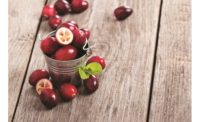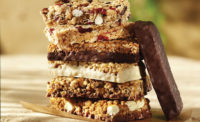The 2015-2020 Dietary Guidelines recommends consuming 2 cup equivalents of fruit and 2½ cup equivalents of vegetables per day, based on a 2,000-calorie diet. But, according to a 2017 CDC study, just 1 out of 10 adults meet the recommended levels. The study notes that as a result, adults are missing out on essential nutrients inherently found in fruits and vegetables.
Depending upon the type, vegetables provide nutrients like dietary fiber, potassium, vitamin A, vitamin C, copper, magnesium, vitamin E, vitamin B6, folate, iron, manganese, thiamine and niacin. Fruits are high in fiber and vitamins and minerals such as vitamin C, potassium and folate, and are also loaded with beneficial antioxidants.
Fruits, vegetables and related inclusions are well positioned to deliver against consumers growing interest in better-for-you and plant-based foods and provide multiple sensory attributes like flavor, color and texture, along with providing great nutrition.
Fruitful options
Mollie Woods, executive director, Cherry Industry Administrative Board, DeWitt, MI, notes consumer palates are shifting and starting to prefer more tangy and sour flavors. This creates an opportunity for Montmorency tart cherries. “Montmorency tart cherries have recently been included in a variety of new products, cropping up in protein bars, energy bites, snack mixes. Montmorency tart cherries are suited for a wide range of bakery and snack innovations, from trail mixes and protein bars to muffins and cookies. They bring a trending sour flavor profile for consumers to discover, a halo of potential health benefits, an attractive pop of bright-red color and an added texture to snack and bakery applications.”
Montmorency tart cherries are grown in the U.S. The products are available year-round in dried, frozen, canned, juice and concentrate formats.
Woods notes that more than 60 scientific studies have been conducted that demonstrate the impact of Montmorency tart cherries on exercise recovery, heart health, sleep, arthritis and gout. She notes, “U.S-grown Montmorency tart cherries are abundant in anthocyanins—a natural compound that contributes to the ruby-red color. This phytonutrient is also behind the potential health-promoting properties of Montmorency tart cherries.”
Blueberries are also a top choice for inclusion in snacks and baked goods. The U.S. Highbush Blueberry Council notes that 2019 was a big year for further processed blueberries. U.S. producers further developed and refined ingredient specification to address the needs of the snack and bakery industry. Kasey Cronquist, president, North American Blueberry Council, Folsom, CA, shares some examples:
- Sized dried blueberries, bits, crumbles and diced. Manufacturers of bars and snack mixes require specific size and shape of dehydrated blueberries. Dried, infused blueberries are now available in diced and crumbles (small bits) of homogenous sizing. This has allowed manufacturers to integrate into products with exact precision, appearance and delivery in extrusion methods.
- Blueberry extract. In 2019, a U.S.-produced blueberry extract attracted a lot of attention in the healthy snack and baking area. The product, called Vita-Blue, is used to give a flavor boost to extruded snacks and bakery applications. The extract delivers a desirable aroma and flavor.
- Blueberry purée and purée concentrates. These liquid ingredients have been around for decades, but in 2019, companies began using the product for color and natural flavor in extruded products. The 20 to 40˚ Brix purée concentrate delivers a very desirable color, and the flavor holds up in extrusion.
Blueberries offer beautiful color, tartness and a slightly sweet flavor profile to foods, while also contributing fiber and vitamin C. Blueberries can be combined with quinoa, chia, hemp and ancient grains and used in crackers, crisps and cookies. The powdered format can be added to popcorn and puffed snacks which can provide color, sweetness and a boost of nutrition.
California prunes are another delicious, nutritious and versatile ingredient that can be used in a range of snack and bakery applications. A serving of 4–5 prunes delivers 3 grams of fiber (11 percent Daily Value) which contributes a good source of fiber, 280 mg of potassium and 23 mcg of vitamin K, a nutrient that is important for blood clotting and bone metabolism. Gut health continues to be an area of growing interest for consumers and has been linked to overall health, and California Prunes are one of the original gut health foods.
“California Prunes enhance savory and sweet applications, help maintain and/or deliver moisture to a product, and provide a nutritious sweetener option,” says Kiaran Locy, director, brand and industry communications, California Prune Board, Roseville, CA. “Whole or diced California prunes are the perfect inclusion to add volume and show the visibility of the fruit, while also offering functionality in a variety of breads, cookies, cakes and bars. California Prune purée can also be used in baked goods to maintain moisture, and extend shelf life while maintaining consumer sensory preferences. California prune juice/concentrate is a natural humectant and caramel color, and also helps to extend, for example, baked goods shelf life, as well as provide a rich color and subtly sweet flavor note.”
Most recently, Fourpoints, Denver, partnered with the California Prune Board to create and promote its new slow-release energy bar. Kevin Webber, co-founder, was looking to disrupt the bar market. “The energy bar category is crowded and full of the same old date and syrup-based bars. You have to have a one-of-a-kind product to stand out, and for us that means a one-of-a-kind ingredient: California prunes.” The bars are available in five different flavors: Alpine Apple Pie, Powder Day PB&J, Backcountry Banana Bread, Trailhead Gingerbread and Mountain Mocha Espresso.
The California Prune Board also works with a global network of culinary professionals to uncover amazing and unexpected flavor experiences. For example, the briny, creamy, salty and umami notes of California Prunes paired with feta cheese, or the combination of dark chocolate and California Prunes that delivers an earthy, deep and sweet taste to differentiate products.
Beneficial formats
In 2012, Milne MicroDried, Nampa, ID, introduced an innovative drying method for fruits and vegetables. “The drying method uses traditional dryers for dehydrating fruits and vegetables,” says Heidi Farkas, national sales and marketing manager. “The drying process is then finished using low-impact microwave energy in a vacuum chamber to better preserve the natural color, rich flavor and size of each piece. This process allows more control of the moisture level, water activity and particle structure of the ingredients. Depending upon the application, the fruit or vegetable piece is then right-sized and available as whole, fragments or powders, and many are available in chewy or crunchy textures.”
The company notes that interest in dried vegetable ingredients is growing. Therefore, Milne MicroDried recently launched 15 new vegetable varieties to add to the portfolio:
- Beet: powder, fragments, slices, diced
- Broccoli: pieces, fragments, powders
- Brussels sprouts: whole, fragments, powder
- Cabbage: fragments, powder
- Carrots: fragments, slices, diced, powder
- Cauliflower: florets, fragments, powder
- Kale: fragments, powder
- Okra: fragments, slices, powder
- Potato (white): cubes
- Pumpkin: fragments, powder
- Rhubarb: fragments, powder
- Spinach: fragments, powder
- Squash (butternut): powder
- Tomato: whole, halves, fragments, powder
- Zucchini: slices, fragments, powder
In addition, the company has expanded its organic offerings to include broccoli, beets, apple, cauliflower, carrot, red bell pepper and spinach.
These new plant-based ingredients have no added sugar, color or preservatives. They’re ideal for vegan, as well as allergen-free and GMO-free, snacks and baked goods. “MicroDried fruit and vegetables are healthy ingredients ideal for adding flavor and color to unbaked, cold-pressed health and energy bars, granola and nut clusters, trail mixes, popcorn flavoring, and confectionary applications such as truffles,” notes Farkas.
Van Drunen Farms, Momence, IL, has also added to its portfolio of fruit and vegetable ingredients. Through a recent global supply chain expansion, the company has gained direct access to the exotic superfruits maqui berry and açaí. “These premium superfruits offer a sweet, tropical flavor and pack a powerful antioxidant-packed punch. Freeze-dried maqui berry and açaí powder retain many of the key attributes of the fresh ingredients, while offering shelf stability and versatility. Our organic, freeze-dried açaí and maqui berry powders both have a vibrant color that adds a pop of purple, ideal for a variety of on-trend applications for today’s innovative food products,” states Andrew Wheeler, vice president of marketing. These products are well suited for the organic, clean-label and better-for-you market. The products provide flavor, color, nutritional benefits and real fruit that can be used in a range to applications, including bars, cookies and salty snacks.
For companies that are interested in making fruit and vegetable serving claims, Van Drunen offers an exclusive program called TruServ. The program connects their extensive production data to the USDA Nutritional database on their fruit, vegetable and leafy green ingredients to help substantiate and verify the number of fruit and vegetable servings claimed by a product.






